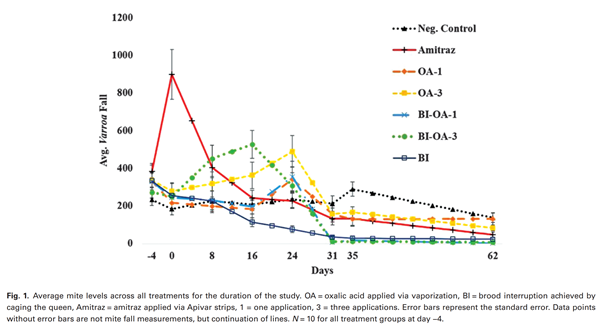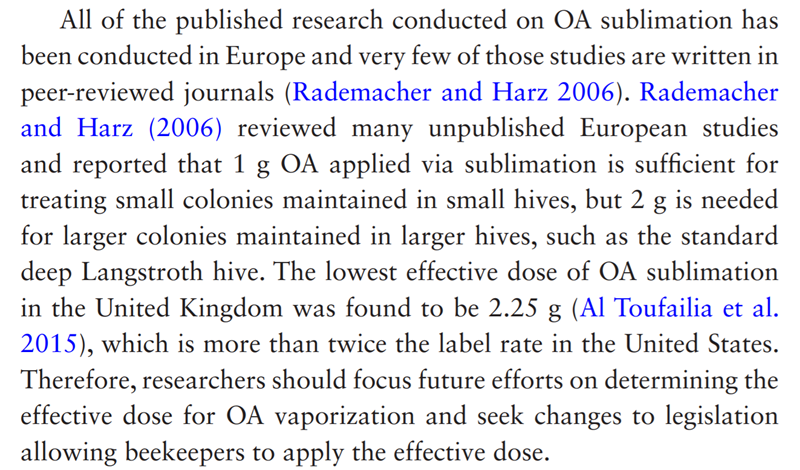- Joined
- Jul 1, 2012
- Messages
- 871
- Reaction score
- 2
New research published:
https://www.ncbi.nlm.nih.gov/pubmed/31909423
Evaluating the Efficacy of Oxalic Acid Vaporization and Brood Interruption in Controlling the Honey Bee Pest Varroa destructor (Acari: Varroidae)
Cameron J. Jack,1,3, Edzard van Santen,2 and James D. Ellis1
Abstract:
A successful Integrated Pest Management approach to Varroa destructor Anderson and Trueman control in managed colonies of western honey bees Apis mellifera Linnaeus (Hymenoptera: Apidae) must be an improvement over conventional control methods and include cost-effective treatments that can be readily employed by beekeepers. Herein, we tested the efficacy of oxalic acid (OA) vaporization and brood interruption as Varroa controls. Sixty experimental colonies were randomly assigned to one of six treatment groups with 10 colonies per group. The six treatments were: 1) OA applied once, 2) OA applied three times, 3) brood interruption, 4) OA applied once + brood interruption, 5) OA applied three times + brood interruption, and 6) no OA or brood interruption. The OA was applied via vaporization, with each application being 1 g OA applied through the hive entrance (label rate), on the bottom board. Brood interruption was accomplished by caging a colony's queen in a queen cage for a period of 24 d. An additional 10 colonies were treated with amitraz (Apivar - positive control). Varroa levels were estimated before, during, and after treatment applications using sticky boards left in colonies for 3 d. Our data suggest that queen caging to achieve brood interruption during the fall season can negatively impact colony strength and survival. We observed high colony mortality in some treatments, despite diligent colony management to alleviate the side effects of the treatments. Colonies treated with amitraz were healthier and had better survival than those treated with OA vaporization. In conclusion, OA and/or brood interruption did not provide sufficient Varroa control.
The "forced brood break" didn't work out very well, and an OA dose of 1g per brood box (Lang) was not enough according to this. The experiment was in very different conditions to here in the UK. There are problems with it, as there often are, but at least they tried. It seems to me that measuring mite falls is not necessarily the same as measuring mite loads.
There has been discussion elsewhere about how to consistently ensure a known dose of OA by sublimation, because it can break down into formic acid, carbon dioxide & carbon monoxide at higher temps.
It makes the case for testing varroa levels with alcohol wash or sugar shake all the more compelling IMO.
https://www.ncbi.nlm.nih.gov/pubmed/31909423
Evaluating the Efficacy of Oxalic Acid Vaporization and Brood Interruption in Controlling the Honey Bee Pest Varroa destructor (Acari: Varroidae)
Cameron J. Jack,1,3, Edzard van Santen,2 and James D. Ellis1
Abstract:
A successful Integrated Pest Management approach to Varroa destructor Anderson and Trueman control in managed colonies of western honey bees Apis mellifera Linnaeus (Hymenoptera: Apidae) must be an improvement over conventional control methods and include cost-effective treatments that can be readily employed by beekeepers. Herein, we tested the efficacy of oxalic acid (OA) vaporization and brood interruption as Varroa controls. Sixty experimental colonies were randomly assigned to one of six treatment groups with 10 colonies per group. The six treatments were: 1) OA applied once, 2) OA applied three times, 3) brood interruption, 4) OA applied once + brood interruption, 5) OA applied three times + brood interruption, and 6) no OA or brood interruption. The OA was applied via vaporization, with each application being 1 g OA applied through the hive entrance (label rate), on the bottom board. Brood interruption was accomplished by caging a colony's queen in a queen cage for a period of 24 d. An additional 10 colonies were treated with amitraz (Apivar - positive control). Varroa levels were estimated before, during, and after treatment applications using sticky boards left in colonies for 3 d. Our data suggest that queen caging to achieve brood interruption during the fall season can negatively impact colony strength and survival. We observed high colony mortality in some treatments, despite diligent colony management to alleviate the side effects of the treatments. Colonies treated with amitraz were healthier and had better survival than those treated with OA vaporization. In conclusion, OA and/or brood interruption did not provide sufficient Varroa control.
The "forced brood break" didn't work out very well, and an OA dose of 1g per brood box (Lang) was not enough according to this. The experiment was in very different conditions to here in the UK. There are problems with it, as there often are, but at least they tried. It seems to me that measuring mite falls is not necessarily the same as measuring mite loads.
There has been discussion elsewhere about how to consistently ensure a known dose of OA by sublimation, because it can break down into formic acid, carbon dioxide & carbon monoxide at higher temps.
It makes the case for testing varroa levels with alcohol wash or sugar shake all the more compelling IMO.







